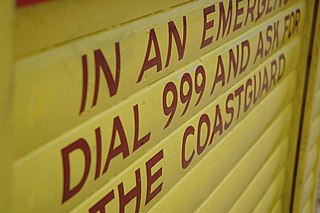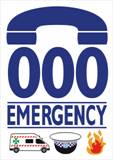Related Research Articles

Throughout the 20th century, telephone switchboards were devices used to connect circuits of telephones to establish telephone calls between users and/or other switchboards. The switchboard was an essential component of a manual telephone exchange, and was operated by switchboard operators who used electrical cords or switches to establish the connections.
Enhanced 911, E-911 or E911 is a system used in North America to automatically provide the caller's location to 911 dispatchers. 911 is the universal emergency telephone number in the region. In the European Union, a similar system exists known as E112 and known as eCall when called by a vehicle.

Most public switched telephone networks have a single emergency telephone number that allows a caller to contact local emergency services for assistance. The emergency number differs from country to country; it is typically a three-digit number so that it can be easily remembered and dialed quickly. Some countries have a different emergency number for each of the different emergency services; these often differ only by the last digit.
A dial tone is a telephony signal sent by a telephone exchange or private branch exchange (PBX) to a terminating device, such as a telephone, when an off-hook condition is detected. It indicates that the exchange is working and is ready to initiate a telephone call. The tone stops when the first dialed digit is recognized. If no digits are forthcoming, the partial dial procedure is invoked, often eliciting a special information tone and an intercept message, followed by the off-hook tone, requiring the caller to hang up and redial.
Caller identification is a telephone service, available in analog and digital telephone systems, including voice over IP (VoIP), that transmits a caller's telephone number to the called party's telephone equipment when the call is being set up. The caller ID service may include the transmission of a name associated with the calling telephone number, in a service called Calling Name Presentation (CNAM). The service was first defined in 1993 in International Telecommunication Union—Telecommunication Standardization Sector (ITU-T) Recommendation Q.731.3.

999 is an official emergency telephone number in a number of countries which allows the caller to contact emergency services for urgent assistance. Countries and territories using the number include Bahrain, Bangladesh, Botswana, Eswatini, Ghana, Hong Kong, Ireland, the Isle of Man, Kenya, Macau, Malaysia, Mauritius, Poland, Qatar, Sudan, Saudi Arabia, Singapore, Trinidad and Tobago, the Seychelles, Uganda, the United Arab Emirates, the United Kingdom, and Zimbabwe.
A busy signal in telephony is an audible call-progress tone or audible signal to the calling party that indicates failure to complete the requested connection of that particular telephone call.
Operator assistance refers to a telephone call in which the calling party requires an operator to provide some form of assistance in completing the call. This may include telephone calls made from pay phones, calls placed station-to-station, person-to-person, collect, third number calls, calls billed to a credit card, and certain international calls which cannot be dialed directly. The telephone operator may also be able to assist with determining what kind of technical difficulties are occurring on a phone line, to verify whether a line is busy, or left off the hook, and break in on a phone line to request for the caller to clear the line for an incoming call. The latter service is often utilized by emergency police. In addition, operators are often a first point of contact for the elderly wanting information on the current date and time.

A telephone call is a connection over a telephone network between the called party and the calling party.
A toll-free telephone number or freephone number is a telephone number that is billed for all arriving calls instead of incurring charges to the originating telephone subscriber. For the calling party, a call to a toll-free number from a landline is free of charge.

In the early days of telephony, companies used manual telephone switchboards, and switchboard operators connected calls by inserting a pair of phone plugs into the appropriate jacks. They were gradually phased out and replaced by automated systems, first those allowing direct dialing within a local area, then for long-distance and international direct dialing.
Phone fraud, or more generally communications fraud, is the use of telecommunications products or services with the intention of illegally acquiring money from, or failing to pay, a telecommunication company or its customers.
Last-call return, automatic recall, or camp-on, is a telecommunication feature offered by telephony service providers to subscribers to provide the subscriber with the telephone number, and sometimes the time, of the last caller. The service may also offer the facility to place a call to the calling party.

The Australian telephone numbering plan describes the allocation of phone numbers in Australia. It has changed many times, the most recent major reorganisation by the Australian Communications and Media Authority taking place between 1994 and 1998.

In telephony, an automated attendant allows callers to be automatically transferred to an extension without the intervention of an operator/receptionist. Many AAs will also offer a simple menu system. An auto attendant may also allow a caller to reach a live operator by dialing a number, usually "0". Typically the auto attendant is included in a business's phone system such as a PBX, but some services allow businesses to use an AA without such a system. Modern AA services can route calls to mobile phones, VoIP virtual phones, other AAs/IVRs, or other locations using traditional land-line phones or voice message machines.

Numbers on the Irish telephone numbering plan are regulated and assigned to operators by ComReg.

000 is the primary national emergency number in Australia. The Emergency Call Service is operated by Telstra and overseen by the Australian Communications and Media Authority, and is intended only for use in life-threatening or time-critical emergencies. Other emergency numbers in Australia are 112 for GSM mobile and satellite phones, which is answered by a 000 operator and 106 for TDD textphones. 000 was also the emergency number in Denmark and Finland until the introduction of the 112 number in 1993 and in Norway until 1986, when the emergency numbers diverted to 001 for fire brigade, 002 for police and 003 for ambulance. Those numbers changed in 1994 to 110, 112 and 113 respectively.
An intercept message is a telephone recording informing the caller that the call cannot be completed, for any of a number of reasons ranging from local congestion, to disconnection of the destination phone, number dial errors or network trouble along the route.

The New Zealand telephone numbering plan describes the allocation of telephone numbers in New Zealand and the Pitcairn Islands.

A telephone number is a sequence of digits assigned to a fixed-line telephone subscriber station connected to a telephone line or to a wireless electronic telephony device, such as a radio telephone or a mobile telephone, or to other devices for data transmission via the public switched telephone network (PSTN) or other public and private networks.